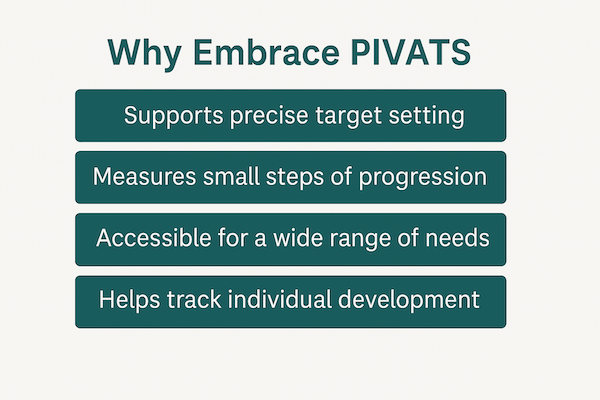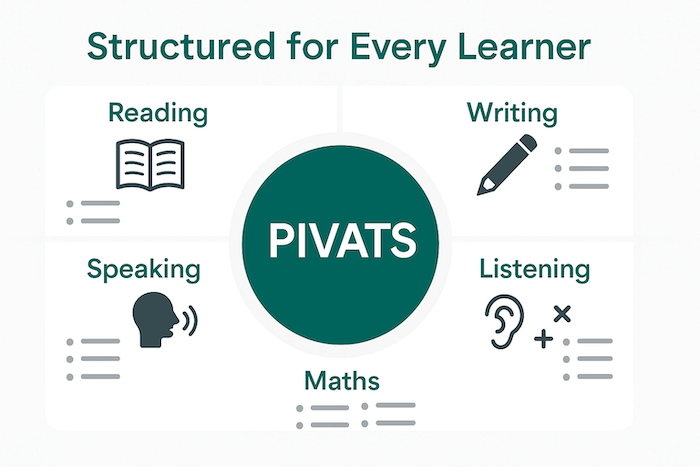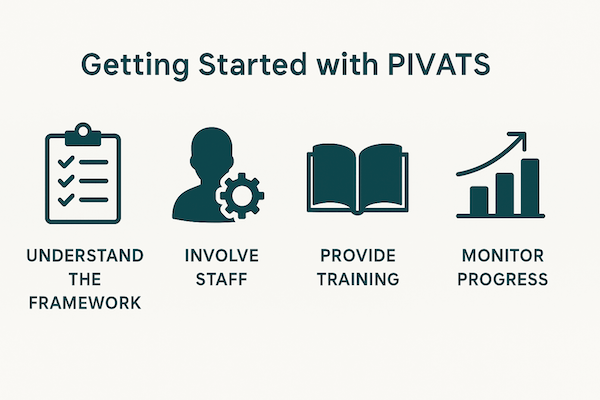PIVATS Explained: Assessment for Pupils with SEND
Track progress for pupils with SEND using PIVATS. This assessment framework turns small steps into visible achievements for every learner.


Measuring progress for pupils with special educational needs requires precision. Traditional assessments miss the small gains that matter most to these learners. You need a framework that captures every step forward.
76% of teachers report that personalized learning improves student engagement. PIVATS provides exactly that: a structured method to assess, track, and celebrate progress for pupils working below national curriculum expectations.
PIVATS stands for Performance Indicators for Valued Assessment and Targeted Learning. Lancashire County Council developed this framework for pupils with significant learning difficulties. The latest version, PIVATS 5, covers Reading, Writing, Speaking, Listening, and Mathematics.
The system breaks broad curriculum goals into specific, observable milestones. Instead of "read a simple text," you get precise indicators like "links sounds to letters" or "blends CVC words." Each indicator represents a clear, achievable target.
The "small steps" approach makes learning visible. For pupils with SEND, the gap between major milestones can stretch across months or years. PIVATS divides this journey into manageable increments.
62% of teachers report frequent job-related stress. PIVATS streamlines your assessment process by replacing ambiguity with clarity. You know exactly where each pupil stands and what comes next.
Performance indicators follow a developmental sequence. When a pupil masters one indicator, the next one becomes their target. This removes guesswork from your planning. Every target stretches the pupil without overwhelming them.

Assessment for Learning requires more than data collection. You need to translate that data into meaningful action. PIVATS makes this connection explicit.
Your assessment reveals gaps. The framework's structure shows you exactly which skills need attention. If a pupil struggles with a mathematical concept, you can design interventions that address that specific barrier.
This precision matters for inclusive practice. Generic support rarely works. Targeted interventions linked directly to assessment data create measurable change.
The assessment cycle starts with observation. You gather evidence during everyday classroom activities. Watch for specific skills against the performance indicators. Record which indicators each pupil has securely mastered.
This data creates a living record. The cycle repeats continuously, informing your daily teaching. You're not ticking boxes once per term. You're building an ongoing understanding of how each pupil develops.
78% of Gen Z students say a teacher makes them excited about the future. When you recognize and celebrate small victories through valued assessment, you build that excitement. Pupils see themselves making progress. They feel capable.
PIVATS aligns with the foundational skills that underpin national standards. The highest PIVATS levels transition smoothly into early Key Stage 1 expectations. You're not working in isolation from the curriculum.
The framework provides a clear pathway. Pupils build prerequisite knowledge at their own pace. When they're ready, they can access broader curriculum content. PIVATS acts as that bridge.
Students with PMLD benefit particularly from this approach. The framework accommodates very early developmental stages while maintaining connection to age-appropriate learning contexts.
Analyzing PIVATS data reveals patterns. You might notice a pupil progressing rapidly in one reading area but remaining static in another. This signals a specific barrier requiring targeted support.
The framework helps identify "spiky profiles" where abilities vary significantly across domains. Understanding these patterns informs your intervention strategies. You're not treating symptoms. You're addressing root causes.
SEND leaders can aggregate PIVATS data across cohorts. This shows which interventions work school-wide. You can identify trends, evaluate provision effectiveness, and allocate resources based on evidence.
PIVATS provides a common language for collaboration. When teachers, SENCos, teaching assistants, and external specialists all use the same framework, communication becomes seamless.
A teacher shares precise PIVATS data with a SENCo to justify additional support. A speech and language therapist sets targets that align with classroom indicators. Everyone works from the same reference point.
This shared understanding extends beyond academic subjects. While PIVATS 5 focuses on core areas, you can adapt the methodology to track PSED (Personal, Social, and Emotional Development), physical education, or creative arts. Development becomes holistic.

Start by selecting relevant indicators for each pupil. Don't feel bound by age expectations. Choose indicators from different developmental levels if needed. The framework bends to fit your pupils, not the reverse.
For pupils with complex profiles, create bespoke pathways. Mix indicators from different subject areas. This flexibility matters for learners with co-occurring conditions or unconventional patterns.
Document evidence as you teach. You don't need separate assessment sessions. Watch for mastery during regular activities. Note when pupils demonstrate skills consistently across contexts. This becomes your assessment record.
Interpreting PIVATS goes beyond ticking boxes. Look for patterns in the data. Which areas show rapid progress? Where has movement stopped? These patterns guide your next teaching decisions.
Compare progress rates across different domains. Uneven development often points to specific barriers. A pupil might advance quickly in practical mathematics but struggle with written recording. The framework makes these disparities visible.
Strategies for assessing student progress work best when they connect directly to teaching. PIVATS closes the loop between what you measure and what you do. The next step is always clear.
Personal, Social, and Emotional Development deserves the same rigorous tracking as academic skills. PIVATS principles apply here too. Break broad goals into observable indicators. Track small steps. Celebrate progress.
You might adapt the framework to measure:
Prime areas of development often support learning in specific areas. A pupil who develops better emotional regulation may suddenly make academic gains. PIVATS lets you see these connections.
Clear milestones reduce uncertainty. You know what good progress looks like at each stage. This confidence affects how you teach. When you trust your assessment, you make bolder instructional choices.
The framework supports conversations with parents too. You can show exactly what their child has achieved using concrete examples. PIVATS data makes abstract progress tangible.
For special educational needs provision, accountability matters. PIVATS provides evidence that stands up to scrutiny. You can demonstrate impact clearly to leadership, inspectors, or external agencies.

No framework works perfectly for everyone. PIVATS requires significant teacher time for observation and recording. You need systems to manage this workload. Some schools use digital tracking tools. Others develop efficient paper-based systems.
The framework can't capture everything. Some learning is non-linear. Pupils sometimes make sudden leaps after long plateaus. PIVATS tracks the steps but may miss the complexity of how learning actually happens.
Used rigidly, any assessment can limit expectations. The framework should support ambition, not cap it. Always ask: what else might this pupil achieve? Keep pushing boundaries even as you celebrate small steps.
Start small. Choose one subject area or one small group of pupils. Learn the system before rolling out school-wide. You'll discover what works in your context.
Train staff together. Everyone needs to understand the indicators and observe consistently. Shared professional development builds that common language you need for effective collaboration.
Review your systems regularly. Which recording methods save time? How often should you update assessments? What makes the data actually useful rather than just collected? Adjust based on what you learn.
Adaptive learning happens when assessment informs teaching directly. PIVATS gives you the precision to make that connection real. Every pupil deserves to see themselves making progress.

You've explored PIVATS in depth. These five research papers extend that understanding. Each one addresses practical challenges you face when tracking progress for pupils working below national expectations.
1. Setting Learning Expectations for Students with Disabilities (Carnine & Granzin, 2001)
This paper outlines a balanced accountability model for special education. The authors argue for clearer expectations and better instructional decisions through precise assessment within the IEP process. You'll find practical guidance on setting targets that challenge without overwhelming pupils.
2. Issues in Data-Based Decision Making in Special Education (Stone, 2001)
Stone identifies a critical gap: we lack benchmarks for acceptable progress in learning-disabled pupils. The paper emphasizes empirical, student-specific data to guide placement decisions. This matters when you're justifying provision or demonstrating impact to leadership.
3. Supporting Schools to Assess the Progress of Pupils with Special Educational Needs Using the P Scales (Fergusson, 2008)
P scales made previously invisible progress measurable. Fergusson shows how this improved inclusive practice and built staff confidence through clearer professional judgment. The parallel to PIVATS is direct. Both frameworks validate small gains that traditional assessment tools miss.
4. Alternative Strategies in Assessing Special Education Needs (Dykeman, 2006)
Dykeman reviews curriculum-based assessment, authentic assessment, and other models within response-to-intervention frameworks. This paper helps you understand where PIVATS fits among broader assessment tools. You'll see how different approaches complement each other for SEND diagnosis and support.
5. Academic Curriculum for Students with Significant Cognitive Disabilities (Karvonen et al., 2011)
This research examines how teachers deliver and assess adapted academic content for pupils with significant cognitive ability differences. The findings reveal ongoing challenges in curriculum planning and highlight where targeted professional development makes the biggest difference. Read this if you work with pupils who need substantial modification to access learning.
Measuring progress for pupils with special educational needs requires precision. Traditional assessments miss the small gains that matter most to these learners. You need a framework that captures every step forward.
76% of teachers report that personalized learning improves student engagement. PIVATS provides exactly that: a structured method to assess, track, and celebrate progress for pupils working below national curriculum expectations.
PIVATS stands for Performance Indicators for Valued Assessment and Targeted Learning. Lancashire County Council developed this framework for pupils with significant learning difficulties. The latest version, PIVATS 5, covers Reading, Writing, Speaking, Listening, and Mathematics.
The system breaks broad curriculum goals into specific, observable milestones. Instead of "read a simple text," you get precise indicators like "links sounds to letters" or "blends CVC words." Each indicator represents a clear, achievable target.
The "small steps" approach makes learning visible. For pupils with SEND, the gap between major milestones can stretch across months or years. PIVATS divides this journey into manageable increments.
62% of teachers report frequent job-related stress. PIVATS streamlines your assessment process by replacing ambiguity with clarity. You know exactly where each pupil stands and what comes next.
Performance indicators follow a developmental sequence. When a pupil masters one indicator, the next one becomes their target. This removes guesswork from your planning. Every target stretches the pupil without overwhelming them.

Assessment for Learning requires more than data collection. You need to translate that data into meaningful action. PIVATS makes this connection explicit.
Your assessment reveals gaps. The framework's structure shows you exactly which skills need attention. If a pupil struggles with a mathematical concept, you can design interventions that address that specific barrier.
This precision matters for inclusive practice. Generic support rarely works. Targeted interventions linked directly to assessment data create measurable change.
The assessment cycle starts with observation. You gather evidence during everyday classroom activities. Watch for specific skills against the performance indicators. Record which indicators each pupil has securely mastered.
This data creates a living record. The cycle repeats continuously, informing your daily teaching. You're not ticking boxes once per term. You're building an ongoing understanding of how each pupil develops.
78% of Gen Z students say a teacher makes them excited about the future. When you recognize and celebrate small victories through valued assessment, you build that excitement. Pupils see themselves making progress. They feel capable.
PIVATS aligns with the foundational skills that underpin national standards. The highest PIVATS levels transition smoothly into early Key Stage 1 expectations. You're not working in isolation from the curriculum.
The framework provides a clear pathway. Pupils build prerequisite knowledge at their own pace. When they're ready, they can access broader curriculum content. PIVATS acts as that bridge.
Students with PMLD benefit particularly from this approach. The framework accommodates very early developmental stages while maintaining connection to age-appropriate learning contexts.
Analyzing PIVATS data reveals patterns. You might notice a pupil progressing rapidly in one reading area but remaining static in another. This signals a specific barrier requiring targeted support.
The framework helps identify "spiky profiles" where abilities vary significantly across domains. Understanding these patterns informs your intervention strategies. You're not treating symptoms. You're addressing root causes.
SEND leaders can aggregate PIVATS data across cohorts. This shows which interventions work school-wide. You can identify trends, evaluate provision effectiveness, and allocate resources based on evidence.
PIVATS provides a common language for collaboration. When teachers, SENCos, teaching assistants, and external specialists all use the same framework, communication becomes seamless.
A teacher shares precise PIVATS data with a SENCo to justify additional support. A speech and language therapist sets targets that align with classroom indicators. Everyone works from the same reference point.
This shared understanding extends beyond academic subjects. While PIVATS 5 focuses on core areas, you can adapt the methodology to track PSED (Personal, Social, and Emotional Development), physical education, or creative arts. Development becomes holistic.

Start by selecting relevant indicators for each pupil. Don't feel bound by age expectations. Choose indicators from different developmental levels if needed. The framework bends to fit your pupils, not the reverse.
For pupils with complex profiles, create bespoke pathways. Mix indicators from different subject areas. This flexibility matters for learners with co-occurring conditions or unconventional patterns.
Document evidence as you teach. You don't need separate assessment sessions. Watch for mastery during regular activities. Note when pupils demonstrate skills consistently across contexts. This becomes your assessment record.
Interpreting PIVATS goes beyond ticking boxes. Look for patterns in the data. Which areas show rapid progress? Where has movement stopped? These patterns guide your next teaching decisions.
Compare progress rates across different domains. Uneven development often points to specific barriers. A pupil might advance quickly in practical mathematics but struggle with written recording. The framework makes these disparities visible.
Strategies for assessing student progress work best when they connect directly to teaching. PIVATS closes the loop between what you measure and what you do. The next step is always clear.
Personal, Social, and Emotional Development deserves the same rigorous tracking as academic skills. PIVATS principles apply here too. Break broad goals into observable indicators. Track small steps. Celebrate progress.
You might adapt the framework to measure:
Prime areas of development often support learning in specific areas. A pupil who develops better emotional regulation may suddenly make academic gains. PIVATS lets you see these connections.
Clear milestones reduce uncertainty. You know what good progress looks like at each stage. This confidence affects how you teach. When you trust your assessment, you make bolder instructional choices.
The framework supports conversations with parents too. You can show exactly what their child has achieved using concrete examples. PIVATS data makes abstract progress tangible.
For special educational needs provision, accountability matters. PIVATS provides evidence that stands up to scrutiny. You can demonstrate impact clearly to leadership, inspectors, or external agencies.

No framework works perfectly for everyone. PIVATS requires significant teacher time for observation and recording. You need systems to manage this workload. Some schools use digital tracking tools. Others develop efficient paper-based systems.
The framework can't capture everything. Some learning is non-linear. Pupils sometimes make sudden leaps after long plateaus. PIVATS tracks the steps but may miss the complexity of how learning actually happens.
Used rigidly, any assessment can limit expectations. The framework should support ambition, not cap it. Always ask: what else might this pupil achieve? Keep pushing boundaries even as you celebrate small steps.
Start small. Choose one subject area or one small group of pupils. Learn the system before rolling out school-wide. You'll discover what works in your context.
Train staff together. Everyone needs to understand the indicators and observe consistently. Shared professional development builds that common language you need for effective collaboration.
Review your systems regularly. Which recording methods save time? How often should you update assessments? What makes the data actually useful rather than just collected? Adjust based on what you learn.
Adaptive learning happens when assessment informs teaching directly. PIVATS gives you the precision to make that connection real. Every pupil deserves to see themselves making progress.

You've explored PIVATS in depth. These five research papers extend that understanding. Each one addresses practical challenges you face when tracking progress for pupils working below national expectations.
1. Setting Learning Expectations for Students with Disabilities (Carnine & Granzin, 2001)
This paper outlines a balanced accountability model for special education. The authors argue for clearer expectations and better instructional decisions through precise assessment within the IEP process. You'll find practical guidance on setting targets that challenge without overwhelming pupils.
2. Issues in Data-Based Decision Making in Special Education (Stone, 2001)
Stone identifies a critical gap: we lack benchmarks for acceptable progress in learning-disabled pupils. The paper emphasizes empirical, student-specific data to guide placement decisions. This matters when you're justifying provision or demonstrating impact to leadership.
3. Supporting Schools to Assess the Progress of Pupils with Special Educational Needs Using the P Scales (Fergusson, 2008)
P scales made previously invisible progress measurable. Fergusson shows how this improved inclusive practice and built staff confidence through clearer professional judgment. The parallel to PIVATS is direct. Both frameworks validate small gains that traditional assessment tools miss.
4. Alternative Strategies in Assessing Special Education Needs (Dykeman, 2006)
Dykeman reviews curriculum-based assessment, authentic assessment, and other models within response-to-intervention frameworks. This paper helps you understand where PIVATS fits among broader assessment tools. You'll see how different approaches complement each other for SEND diagnosis and support.
5. Academic Curriculum for Students with Significant Cognitive Disabilities (Karvonen et al., 2011)
This research examines how teachers deliver and assess adapted academic content for pupils with significant cognitive ability differences. The findings reveal ongoing challenges in curriculum planning and highlight where targeted professional development makes the biggest difference. Read this if you work with pupils who need substantial modification to access learning.